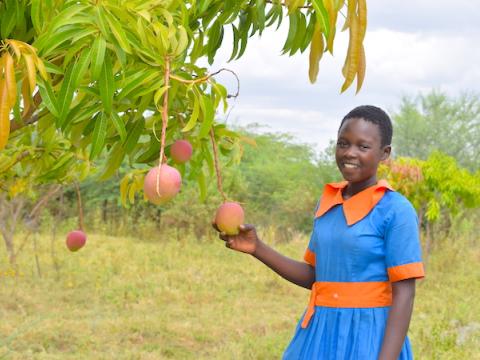Child environmental champions tackle drought challenges through tree planting in schools

By Sarah Ooko, World Vision Senior Communications & Media Officer, Kenya
Fourteen-year-old Stella is an environmental conservation champion at her school in Baringo County, Kenya.
Her love for nature inspired Stella to join the school’s environment club after being taught about the benefits of trees by one of her teachers that founded the club.
“We used to have a lot of bare land in the school compound and the sun would be so hot all year round. Yet, each day we had to walk for long distances in search of water for drinking and cleaning in school,” she says.
To Stella and other pupils, these challenges never seemed to go away and they appeared to be part of their normal life.

“For as far as I can remember, my community has always dealt with the effects of the extremely hot sun and weather conditions. Every now and then, we experience long dry spells that kill livestock, destroy crops and swallow our water bodies. Sometimes children or their parents become sick and die due to the lack of water and food," she says.
These problems bothered Stella for a long time and she kept wondering why they had to suffer. Feeling hopeless, Stella began praying to God to make things better for her community by bringing solutions to the challenges that they were going through.
The answers came through her environmental club patron and teacher, Raymond. He taught pupils at the school about climate change, its devastating effects - such as long dry spells - as well as how these problems could be tackled through planting trees.

"The knowledge enabled us to see the connection between the state of our environment and the life we were living in the community. We realised that to change our lives, we had to plant trees to protect our environment. Our teacher also told us that when he was a child, people never used to cut trees and so the community didn't face the many challenges it was grappling with today," she states.
This realisation pushed Stella, with the support of other children in the club, to actively begin boosting tree cover in the school through a low-cost tree growth and revival technique known as the Farmer Managed Natural Regeneration (FMNR) approach that they learnt through the support of World Vision.
This simple and sustainable reforestation approach promotes the growth of indigenous trees from already existing tree stumps or naturally occurring seeds on the ground.

The hard work eventually paid off. Soon the bare land in school was covered by a ‘small’ forest that has brought immense benefits to children at the school.
"It's still hot out there but the temperatures are cooler in the school compound, thanks to the trees. Now we can concentrate and learn well in class, even during hot afternoons when we used to sweat a lot. We also come to our forest to relax during class breaks in the good atmosphere it provides," states Stella.
As the population of trees in the school kept increasing, a nearby stream that was usually dry - save for a few weeks during the rainy season - began filling up with water that kept flowing even during dry spells.

In addition, the enhanced tree cover boosted the growth of grass that rapidly covered the school's bare land. The grass and trees provide fodder for animals. As such, positive changes opened windows of opportunities for the school's administration. They began keeping livestock that provides meat and milk for the children and also helps to generate income for the school.
With the ever flowing stream water, the school is also able to practice irrigation and grow maize as well as food crops that improve the nutrition and health status of children.
The readily available organic manure that the school gets from livestock has greatly helped to boost crop yields and productivity, leading to bumper harvests.

Stella notes that when it comes to food preparation at the school, children no longer have to walk for long distances to fetch water or collect firewood for cooking.
"This has saved us from the fatigue and strain that we used to feel while undertaking the chores. We simply get the firewood from our small forest in the compound and clean water from the nearby stream. This gives us more time to learn and play," she says.
Cases of school absenteeism have also reduced as pupils can easily get water and food at school.
"During the drought period when most families faced food and water shortages, many children would sleep hungry and therefore lack energy to come to school, attend classes or perform additional tasks assigned to them. They suffered a lot," says Stella

The benefits that the children have reaped from the increased tree cover in their school have given them hope for a bright future in their community.
"We have seen the wonders that the trees have done in our school. This has encouraged all pupils, including those that are not in the environment club to become interested in planting and protecting trees. They have now began practising the FMNR approach in their homes," says a beaming Stella.